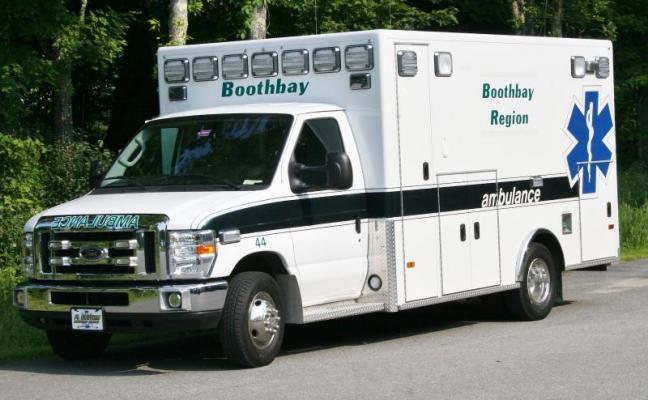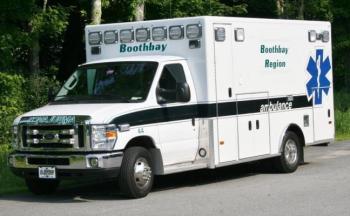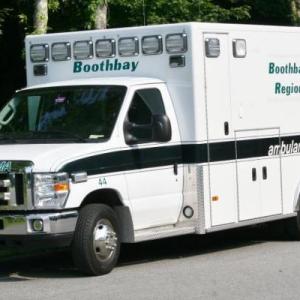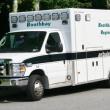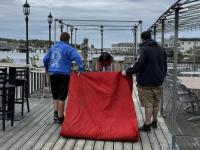Ambulance service responds to change
Last year when Lincoln County Healthcare announced its decision to close St. Andrews’ emergency room, the Boothbay Region Ambulance Service had to plan for unfamiliar territory. The service that had grown up around a local hospital now had to shift to transporting patients solely to hospitals off the peninsula.
To compensate for lost revenue and extra expenses, the ambulance service turned to Boothbay, Boothbay Harbor and Southport for financial support and its annual town subsidy increased five-fold.
Now, three months into the post ER world, BRAS Operations Manager Scott Lash said, “Everything is pretty much going as anticipated and we feel confident we have covered all the bases.”
In November, BRAS Director Rob Ham informed the Boothbay Harbor selectmen that BRAS’s budget projections may have been overly pessimistic and they might need less support from the towns. Ham retracted that preliminary assessment this month in reports to both Boothbay and Boothbay Harbor boards, as the loss of transfers out of St. Andrews Hospital and summer revenues began to be felt in the budget.
“I spoke too hastily,” Ham said.
Fewer transfers, more staff
The dramatic increase in the BRAS budget and taxpayer support is tied primarily to two factors: loss of inter-facility transfers from St. Andrews Hospital and increased staffing to offset more time spent off the peninsula.
Inter-facility transfers provide an important source of revenues for ambulance services, helping to fill the downtime income void. In recent years, BRAS had seen a steady rise in transfers out of St. Andrews ER as the hospital reduced (and ultimately, stopped) admitting acute care patients.
Data provided by Ham shows BRAS handled just under 600 inter-facility transfers in 2013, most from St. Andrews ER. At a charge of about $250-300 per transfer, transfers have provided almost $200,000 in annual revenue.
When the ER closed, transfer calls from St. Andrews, and a significant source of revenue, dried up for BRAS.
The occasional transfer from St. Andrews’ urgent care center does occur, but Lash said these are infrequent and Medicare compensates BRAS less for urgent care transfers. Lash said BRAS is getting transfers from Miles Memorial Hospital in Damariscotta when they involve a Boothbay peninsula resident.
But transfers from other hospitals, such as Mid Coast in Brunswick, which has a contract with North East Mobile Health Service, are infrequent. “Unless a patient at Mid Coast asks for us, we won’t get the transfer,” Lash said. “It’s a learning curve for patients to realize they have to ask for us.”
He said it was still too early to predict how many transfers and how much transfer revenue would be realized this fiscal year.
The other large financial change for BRAS is the shift to two round-the-clock crews to compensate for the longer travel time associated with emergency transports.
“The first reaction of the community to the budget was ‘Why do they need so much staff in the winter? There’s nothing going on’,” Lash said.
Lash said relying on volunteers is no longer an option because overall call time has at least doubled. “People can no longer leave work, respond to an emergency and be back in an hour as they did when the St. Andrews ER was open,” Lash said.
The training requirements and skill set for emergency responders have also increased. Training is both costly and time consuming, Lash said. “This is not the kind of stuff that someone does for free,” he said.
Lash also said the idea that either Wiscasset EMS or Central Lincoln County EMS could provide backup response for the Boothbay peninsula is not realistic. “They are in no better shape than we are,” Lash said. “Physically, it could not happen.”
BRAS data provided by Ham show BRAS responded to 1,480 calls in 2013, of those 617 were emergency calls that required patient transport to a hospital. Prior to the ER closing, 91 percent of emergency patients in 2013 were taken first to St. Andrews ER. Since October 1, 78 percent of emergencies were transported by BRAS to Miles and 22 percent to Mid Coast.
Overall, the first crew responded to 75 percent of the 2013 calls, the second crew 21 percent, and the third and fourth (on call) crews 4 percent (see graph).
Consistent with the seasonal population boom, ambulance call volume and the reliance on second, third and fourth crews were highest from May through September. November had the lowest number of calls (91) and August the highest (180). Ham did not provide a breakdown of calls versus time of day, but Lash said the highest call volume occurs between 10 a.m. and 4 p.m.
Positioning for the future
As healthcare changes, Lash said small ambulance services have to adapt to survive. “We are now becoming mobile healthcare,” Lash said. “More and more EMS is being relied on as a primary provider of healthcare rather than just responding to severe, acute crisis.”
It can be difficult for a small ambulance service, particularly located at the end of a peninsula, to compete with large regional services, but BRAS has worked to hire and train skilled staff and embrace novel programs.
“We used to operate in a captive market, now we’re in a competitive market with other services,” Lash said, “We have to position ourselves so we can operate in that competitive market.”
Two examples of positioning Lash cites are critical care transport and community paramedicine. Lash said six BRAS EMTs recently completed critical care transport training, which is the highest level of transport care for the sickest of patients. BRAS originally envisioned its usefulness when St. Andrews ER was still open.
Although St. Andrews’ emergency room has closed, BRAS expects critical care skills to be useful to both the service and the community. Lash said BRAS is the only service with critical care capability and equipment in the area and he is banking on this unique skill set being needed by Miles and other hospitals. The additional training also means BRAS can provide higher level care and treatment in emergencies.
BRAS staff are also being trained in community paramedicine, a cooperative venture with Lincoln County Healthcare that will be launched in February. Community paramedicine involves EMT home visits to high risk patients to keep them on the road to health and out of the hospital.
Although not currently covered by Medicare or insurers, Lash said he sees this program as a service EMTs can provide during downtime. “It one more way we can provide service for the money we have been given in subsidy,” he said.
Looking ahead
It’s budget season for Southport, Boothbay and Boothbay Harbor and local towns are anxious for next year’s BRAS budget. Lash said he has begun the process, but with only a few months of data the proposed budget will again rely on some conjecture.
“I expect the expense budget to be similar to what we’re doing now,” Lash said. “What may be different is the revenue.”
Lash said BRAS has asked selectmen to appoint town representatives to the BRAS board to facilitate ongoing dialog.
Event Date
Address
United States

